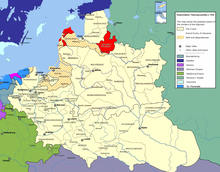Livonia Voivodeship

The Livonia Voivodeship (Polish Województwo inflanckie ), also known as Polish Livonia , was an administrative unit in the Kingdom of Poland-Lithuania , which was formed from the Wenden Voivodeship of the Duchy of Livonia in 1621 and which lasted until the First Partition of Poland in 1772.
The voivodship was the remainder of Livonia that remained with Poland after the war against Sweden 1621–1629 , which had come under Polish sovereignty in 1561. From the Polish side, Swedish sovereignty over the other parts of Livonia was only recognized in the Treaty of Oliva in 1660.
The voivodeship retained the status of the duchy of not belonging to any of the halves of the empire of Poland-Lithuania, but rather being a condominium of both.
The seat of the voivode was Dünaburg (Polish Dyneburg , Lat. Daugavpils ).
The main part of the voivodeship corresponds to today's Latgale landscape in Latvia , which, unlike the rest of the country, is traditionally Catholic because of its longer membership of Poland.
The Pilten area (Lat. Piltene ) of the former bishopric of Courland was administered from 1617 to 1656 as part of the Duchy of Livonia. From 1717, Poland-Lithuania again enforced direct rule over the Duchy of Courland. During this period the area was administered from the Livonia Voivodeship.
Voivodes
- Przecław Leszczyński
- Alexander Morszlyn
- Jan Teodor
- Jerzy Płatem
- Otto Fryderyk Felkierzamb
- Jan Koss
- Jędrzej Głębocki
- Piotr Przebendowski
- Antozi Morsztyn
- Wilhelm Płatem
- Jan Borch
- Stanislaw Brzostowski
- Jozafat (Jan) Zyberg
- Gaspar Rogaliński
- Adam Falkierzamb
literature
- Gert von Pistohlkors : German history in Eastern Europe: Baltic countries, Siedler Verlag, Berlin 2002. ISBN 3-88680-774-6
- Latvijas vēstures atlants. Rīga: Jāņa sēta, 1998. 16.lpp.

